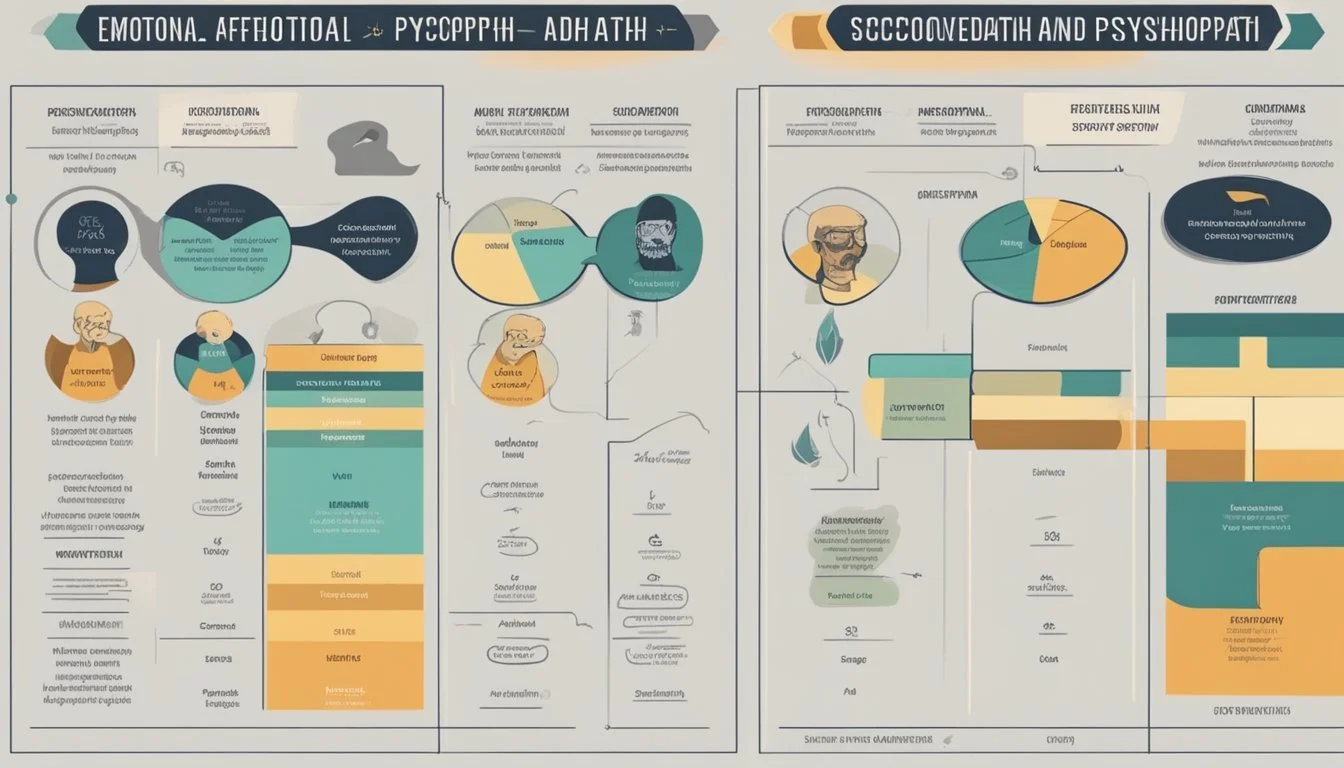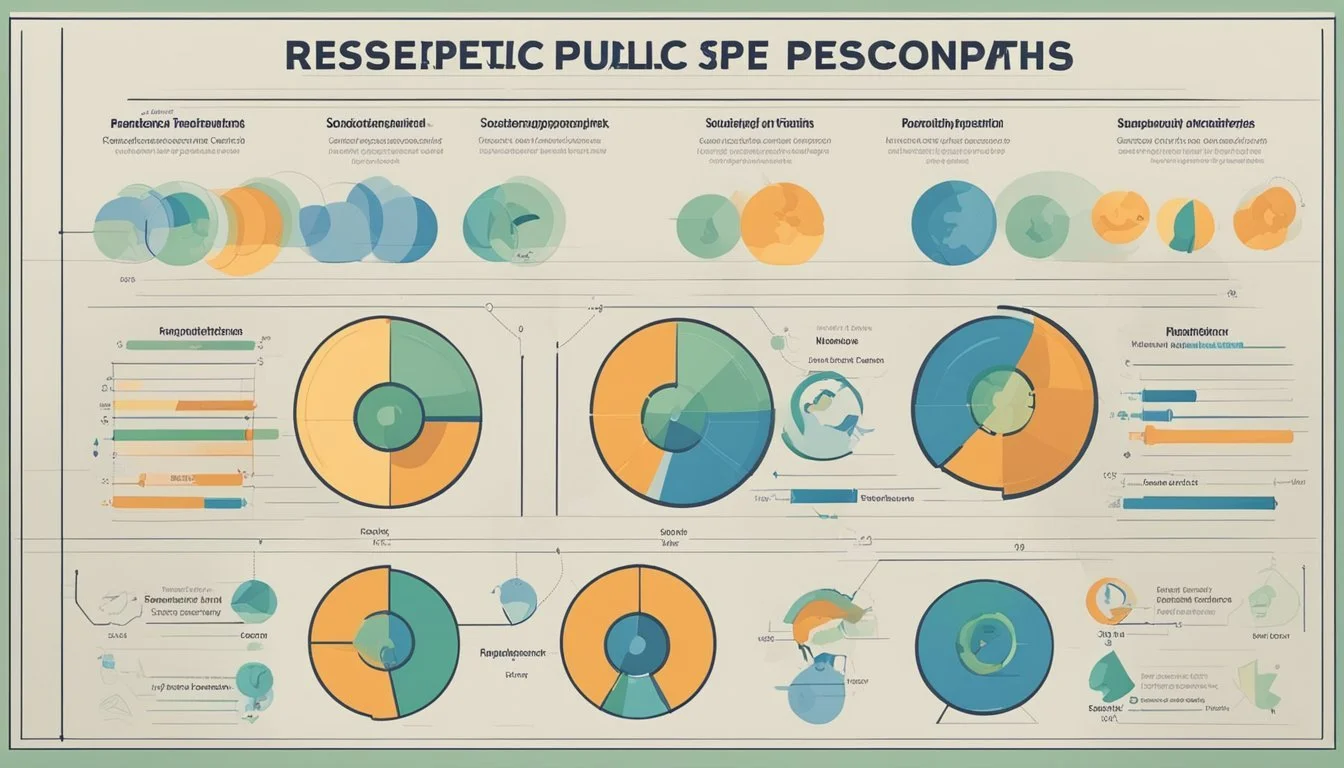Comparing Sociopaths and Psychopaths: Key Differences Chart
Psychopaths and sociopaths are often confused due to their similar antisocial behaviors, but they have distinct characteristics that set them apart. Both fall under the umbrella of antisocial personality disorder, yet psychopathy is generally considered more severe and deeply ingrained. Psychopaths typically lack conscience and empathy, while sociopaths may have a weak moral compass influenced by environmental factors.
The origins of these conditions differ as well. Psychopathy is thought to have a stronger genetic component, whereas sociopathy is believed to be more influenced by upbringing and social environment. This distinction impacts their behavior patterns, with psychopaths often displaying calculated, unemotional actions and sociopaths tending towards more impulsive and erratic conduct.
Understanding these differences is crucial for mental health professionals, law enforcement, and society at large. A chart comparing psychopaths and sociopaths can provide a clear visual representation of their unique traits, helping to dispel common misconceptions and improve recognition of these complex personality disorders.
Understanding Personality Disorders
Personality disorders are complex mental health conditions that affect behavior patterns and interpersonal relationships. They involve enduring and inflexible traits that deviate from cultural norms and cause distress or impairment.
Defining Antisocial Personality Disorder
Antisocial Personality Disorder (ASPD) is characterized by a disregard for social norms and the rights of others. Individuals with ASPD may engage in manipulative, deceitful, or aggressive behaviors without remorse.
Key traits of ASPD include:
Lack of empathy
Impulsivity
Disregard for laws and social norms
Persistent lying or stealing
Reckless behavior
ASPD is diagnosed in adults aged 18 or older, but signs often emerge in childhood or adolescence. It affects approximately 1-4% of the population, with a higher prevalence in males.
Personality Disorders and Mental Health
Personality disorders are a distinct category of mental health conditions. They differ from mood disorders or anxiety disorders in their pervasive and long-standing nature.
These disorders affect:
Thinking patterns
Emotional responses
Interpersonal functioning
Impulse control
Treatment for personality disorders often involves long-term psychotherapy. Cognitive-behavioral therapy and dialectical behavior therapy are common approaches. Medication may be prescribed to manage specific symptoms but is not a primary treatment for the disorder itself.
Role of the Diagnostic and Statistical Manual of Mental Disorders (DSM-5)
The DSM-5 is the primary diagnostic tool for mental health professionals in the United States. It provides standardized criteria for diagnosing personality disorders, including ASPD.
Key aspects of the DSM-5's approach to personality disorders:
Diagnostic criteria are clearly defined
Symptoms must be persistent and stable over time
Diagnosis requires significant impairment in functioning
The DSM-5 lists ten specific personality disorders, including antisocial, borderline, and narcissistic. It also includes a category for other specified personality disorders and personality change due to medical conditions.
Comparing Psychopathy and Sociopathy
Psychopathy and sociopathy are distinct but related antisocial personality disorders. They share some common traits but differ in key aspects of behavior, emotional capacity, and origins.
Core Characteristics of Psychopathy
Psychopaths typically display a cold, calculating demeanor. They lack empathy and conscience, often appearing charming and charismatic on the surface. Psychopaths are skilled at mimicking emotions and manipulating others for personal gain.
Their behavior tends to be carefully planned and executed. They rarely act impulsively, instead methodically pursuing their goals without regard for others' wellbeing.
Psychopaths struggle to form genuine emotional connections. They view relationships as transactional, using people as means to an end. Their lack of empathy allows them to harm others without remorse.
Key Features of Sociopathy
Sociopaths exhibit impulsive and erratic behavior. They often act without considering consequences, leading to frequent conflicts with others. Unlike psychopaths, sociopaths may experience some degree of empathy or guilt, albeit limited.
Their emotional responses tend to be shallow and short-lived. Sociopaths can form attachments, but these relationships are usually unstable and tumultuous.
Sociopaths struggle with following social norms and rules. They frequently engage in criminal behavior, driven by impulsivity rather than calculated planning. Their actions often stem from a disregard for societal expectations rather than a complete lack of conscience.
Overlap and Distinctions in Traits
Both psychopaths and sociopaths fall under the umbrella of antisocial personality disorders. They share traits such as disregard for others' rights, lack of remorse, and manipulative tendencies.
Key differences lie in their emotional capacity and behavior patterns. Psychopaths are more controlled and calculating, while sociopaths tend to be more volatile and impulsive.
Origins also differ: psychopathy is believed to have a stronger genetic component, while sociopathy is more influenced by environmental factors like childhood trauma or abuse.
Diagnostic criteria overlap, making precise differentiation challenging. Both conditions exist on a spectrum, with varying degrees of severity and trait expression among individuals.
Genetic and Environmental Influences
Both genetic predispositions and environmental factors play crucial roles in shaping psychopathic and sociopathic traits. Research indicates complex interactions between biology and upbringing in the development of these personality disorders.
Biological Factors and Brain Structures
Genetics contribute significantly to psychopathic tendencies. Twin studies show heritability estimates of 40-60% for psychopathic traits. Brain imaging reveals structural and functional differences in psychopaths' amygdalas, the region responsible for processing emotions.
Psychopaths often display reduced amygdala volume and activity. This can lead to impaired fear responses and emotional processing. Genetic variations affecting neurotransmitter systems, particularly serotonin, have been linked to psychopathic behaviors.
Brain injuries, especially to the prefrontal cortex, may increase the risk of developing sociopathic traits. These injuries can impair impulse control and decision-making abilities.
The Impact of Upbringing and Environment
Environmental factors strongly influence sociopathic development. Childhood trauma, abuse, neglect, and inconsistent parenting can contribute to antisocial behaviors. Exposure to violence or criminal behavior may normalize such actions.
Sociopaths often come from unstable or dysfunctional families. Lack of emotional bonding or attachment in early childhood can hinder empathy development. Peer influences and societal factors also play roles in shaping sociopathic tendencies.
Negative life experiences can interact with genetic predispositions, potentially triggering or exacerbating psychopathic traits. Supportive environments may help mitigate genetic risks for antisocial behaviors.
Behavioral Patterns and Social Interactions
Sociopaths and psychopaths exhibit distinct patterns in their social behaviors and interactions. These differences manifest in how they form relationships, engage in deception, and handle responsibilities.
Relationships and Manipulative Tendencies
Psychopaths often form shallow relationships, viewing others as objects to be used. They employ charm and charisma to manipulate people for personal gain. Their interactions lack genuine emotional depth.
Sociopaths may form superficial bonds but struggle to maintain long-term relationships. They can be erratic and unpredictable in social settings. While capable of manipulation, their tactics are typically less refined than those of psychopaths.
Both groups tend to exploit others. Psychopaths do so methodically, while sociopaths act more impulsively. Neither feels true empathy or remorse for their actions.
Lying and Deceitful Behavior
Psychopaths are skilled liars, crafting elaborate falsehoods without guilt. They maintain consistent narratives and rarely show signs of nervousness when deceiving others.
Sociopaths also engage in frequent lying but may be less adept at it. Their lies can be more obvious and poorly constructed. They might become defensive or aggressive when challenged about their deceptions.
Both groups use lying as a tool to achieve their goals. Psychopaths lie strategically, while sociopaths may lie reactively or out of habit.
Impulsivity and Irresponsibility
Sociopaths display high levels of impulsivity. They often act without considering consequences, leading to erratic behavior. This impulsiveness can result in frequent job changes, legal troubles, or unstable living situations.
Psychopaths show more controlled behavior. While they may engage in risky activities, their actions are usually calculated. They can maintain a facade of responsibility when it serves their interests.
Both groups struggle with long-term commitments and responsibilities. Sociopaths tend to abandon obligations impulsively, while psychopaths may manipulate situations to avoid accountability.
Emotional and Affective Differences
Sociopaths and psychopaths display distinct emotional and affective traits that set them apart. These differences manifest in their capacity for empathy, remorse, and ability to form emotional connections with others.
Empathy and Remorse
Sociopaths exhibit a limited ability to feel empathy and remorse. They may experience shallow emotions and can occasionally feel guilt for their actions. However, these feelings are typically short-lived and do not significantly impact their behavior.
Psychopaths, in contrast, lack empathy and remorse entirely. They are unable to genuinely care about others' feelings or well-being. This absence of emotional response allows them to engage in harmful acts without experiencing guilt or regret.
Both sociopaths and psychopaths may display anger, but for different reasons. Sociopaths often react impulsively with rage when frustrated or challenged. Psychopaths, however, use anger strategically to manipulate or intimidate others.
Ability to Form Emotional Attachments
Sociopaths can form superficial emotional bonds with others. These relationships are often unstable and self-serving. They may appear to care for certain individuals but struggle to maintain deep, meaningful connections over time.
Psychopaths are incapable of forming genuine emotional attachments. They view relationships purely as means to an end. Their interactions with others are calculated and devoid of authentic emotional investment.
While sociopaths might experience fleeting moments of affection, psychopaths remain emotionally detached in all their interactions. This fundamental difference affects their interpersonal relationships and social behaviors significantly.
Legal Implications and Criminal Behavior
Psychopaths and sociopaths often engage in criminal activities, leading to distinct interactions with the legal system. Their behavioral patterns influence arrest rates, court proceedings, and incarceration outcomes.
Interactions with the Law and Rights
Psychopaths typically display more calculated behavior when dealing with law enforcement. They may attempt to manipulate the system through charm or deception. Sociopaths, being more impulsive, often react aggressively during arrests or questioning.
Both groups retain the same legal rights as other citizens. However, their mental conditions can impact court proceedings. Lawyers may use their diagnoses as part of insanity pleas or to argue for reduced sentences.
Courts sometimes mandate mental health evaluations for suspected psychopaths or sociopaths. These assessments help determine competency to stand trial and potential treatment needs.
Prison Rates and Recidivism
Psychopaths and sociopaths are overrepresented in prison populations. Studies estimate that 15-25% of inmates meet the criteria for psychopathy, compared to about 1% in the general population.
Recidivism rates are significantly higher for these groups:
Psychopaths: 70-80% reoffend within 5 years
Sociopaths: 50-60% reoffend within 5 years
General prison population: 40-50% reoffend within 5 years
Rehabilitation programs often struggle to effectively treat psychopaths and sociopaths due to their lack of empathy and resistance to behavioral change.
Severity of Criminal Acts
Psychopaths tend to commit more severe and violent crimes compared to sociopaths. Their lack of empathy and calculated nature lead to premeditated acts of violence.
Common crimes associated with psychopathy:
Serial killings
White-collar fraud
Organized crime leadership
Sociopaths more frequently engage in:
Impulsive assaults
Petty theft
Drug-related offenses
Both groups show higher rates of domestic violence and sexual assault compared to the general population. Psychopaths often use manipulation and coercion, while sociopaths rely on intimidation and physical force.
Law enforcement agencies sometimes employ specialized tactics when dealing with suspected psychopaths or sociopaths to mitigate risks and improve investigative outcomes.
Diagnosis and Mental Health Assessment
Diagnosing sociopathy and psychopathy involves specific criteria and professional evaluation. Mental health professionals use standardized tools and clinical expertise to assess these complex conditions.
Identifying Criteria and Assessment Tools
The diagnosis of antisocial personality disorder (ASPD) relies on established criteria from the Diagnostic and Statistical Manual of Mental Disorders (DSM-5). Key indicators include a persistent disregard for others' rights, deceitfulness, impulsivity, and lack of remorse.
Psychopathy is often assessed using the Psychopathy Checklist-Revised (PCL-R). This 20-item scale measures traits like superficial charm, callousness, and poor behavioral controls.
Conduct disorder in childhood is a precursor to ASPD diagnosis in adults. Clinicians look for patterns of aggressive, destructive, or deceitful behavior before age 15.
The Role of Mental Health Professionals
Psychiatrists and psychologists are crucial in diagnosing and assessing sociopathy and psychopathy. They conduct thorough interviews, review patient histories, and may use psychological tests.
These professionals differentiate between ASPD and other mental health conditions with similar symptoms. They also evaluate the severity and potential risks associated with the disorder.
Mental health experts consider environmental factors, genetic predispositions, and brain structure abnormalities in their assessments. Their diagnoses inform treatment plans and legal decisions in some cases.
Accurate diagnosis requires extensive training and experience. Professionals must be cautious to avoid misdiagnosis, as these conditions can be complex and overlapping with other disorders.
Treatment Strategies and Support
Effective management of psychopathic and sociopathic traits involves a combination of therapeutic approaches and support systems. The focus is on controlling behaviors and building coping skills.
Medication and Psychotherapy
Psychotherapy forms the cornerstone of treatment for both conditions. Cognitive-behavioral therapy helps individuals recognize harmful thought patterns and develop healthier behaviors. Dialectical behavior therapy can improve emotional regulation and interpersonal skills.
Medication may be prescribed to address specific symptoms. Mood stabilizers can help manage impulsivity and aggression. Antidepressants or anti-anxiety medications may be used for co-occurring conditions.
Psychoeducation is crucial. It helps individuals understand their condition and its impact on their lives and relationships.
Support Systems and Safety Planning
Building a strong support network is essential. Family therapy can improve relationships and create a more stable environment. Support groups offer peer understanding and coping strategies.
Safety planning is critical, especially for individuals with a history of violence. This involves identifying triggers and developing strategies to manage potentially dangerous situations.
Professional monitoring and regular check-ins help track progress and adjust treatment as needed. Vocational training and life skills coaching can improve social functioning and reduce antisocial behaviors.
Legal and ethical considerations often play a role in treatment planning, particularly for individuals involved in the criminal justice system.
Research, Trends, and Public Perception
Recent studies have shed new light on psychopathy and sociopathy, influencing both scientific understanding and public awareness. Researchers continue to explore the prevalence and characteristics of these conditions.
Prevalence and Public Awareness
Estimates suggest that psychopathy affects about 1% of the general population, while sociopathy may be more common at 3-4%. Public awareness of these conditions has increased in recent years, partly due to media portrayals in movies and TV shows.
Mental health professionals emphasize the importance of accurate information to combat misconceptions. Many people confuse psychopathic behaviors with other mental health conditions, leading to potential misdiagnoses.
Narcissism is often associated with psychopathy and sociopathy, though they are distinct conditions. Research indicates some overlap in traits, particularly in areas of empathy and interpersonal relationships.
Changing Views on Psychopathy and Sociopathy
Scientific perspectives on psychopathy and sociopathy have evolved over time. Modern research focuses on understanding these conditions as complex spectrums rather than simple categories.
Studies explore the role of genetics and environment in the development of psychopathic and sociopathic traits. This research aims to inform prevention and treatment strategies.
Recent trends in psychology challenge the notion that all individuals with these traits are inherently dangerous. Some studies suggest that certain psychopathic characteristics, like charisma and fearlessness, can be advantageous in specific professional settings.
Public perception is slowly shifting as well. While stigma remains, there's growing recognition that psychopathy and sociopathy are intricate mental health issues requiring nuanced understanding and approach.








